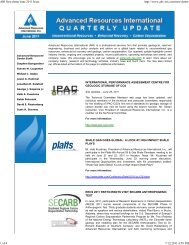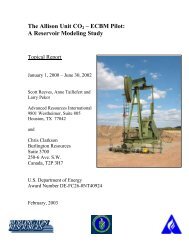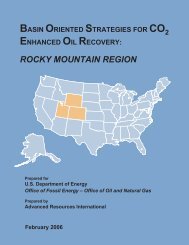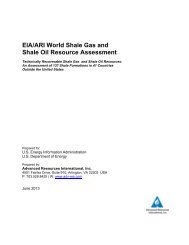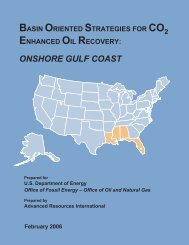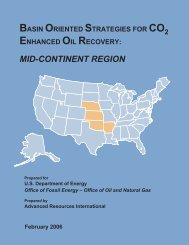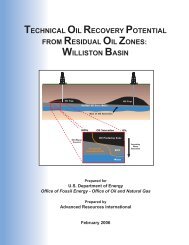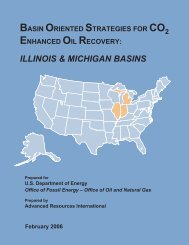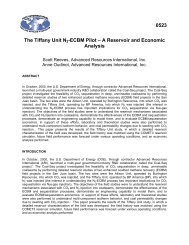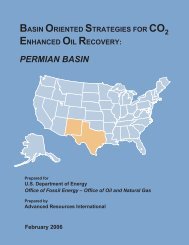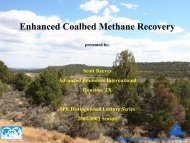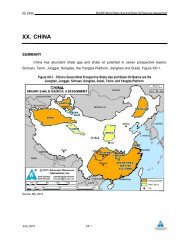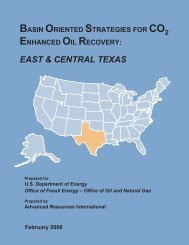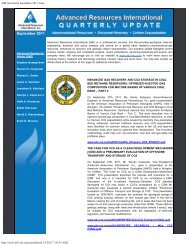Assessing Technical and Economic Recovery of Oil Resources
Assessing Technical and Economic Recovery of Oil Resources
Assessing Technical and Economic Recovery of Oil Resources
You also want an ePaper? Increase the reach of your titles
YUMPU automatically turns print PDFs into web optimized ePapers that Google loves.
B. Examining the Effects <strong>of</strong> Hydrodynamics <strong>and</strong> Reservoir Propertieson Creating a Tilted OWC. Some in the industry have questioned whether (<strong>and</strong>how) hydrodynamic flow is truly able to reshape the oil column in a reservoir, resulting ina substantial ROZ. One answer to this question is set forth in the theoretical equationabove. This equation states that the tilt <strong>of</strong> the OWC <strong>and</strong> the subsequent development<strong>of</strong> the ROZ are influenced by aquifer flow rates <strong>and</strong> reservoir properties. To explore thisissue in more depth, we first constructed a hypothetical 2-D cross section <strong>of</strong> a typicalPermian Basin oil reservoir <strong>and</strong> its underlying aquifer. Next, we subjected this reservoirto varying horizontal aquifer flow rates <strong>and</strong> permeability values to examine the effect <strong>of</strong>these variables on the OWC tilt <strong>and</strong> the creation <strong>of</strong> a ROZ.Figure 6, Initial <strong>Oil</strong> Reservoir/Aquifer Conditions, shows the initial geometry <strong>of</strong>the reservoir/aquifer cross section before a change in aquifer flow is induced. TheWasson Denver Unit San Andres reservoir was used for input data for the simulation.The key reservoir data include: porosity (12%), horizontal permeability (5 md), verticalpermeability (0.5 md), oil gravity (33°API), <strong>and</strong> residual oil saturation (35%), amongothers. This 2-D system is 5,000 ft long horizontally <strong>and</strong> 600 ft tall vertically, with a 400ft thick original oil column. Next, published Permian Basin San Andres formationcapillary forces were imposed on the reservoir/aquifer, resulting in a 50 ft thick transitionzone (TZ) <strong>and</strong> a 350 ft thick main pay zone. A 200 ft thick aquifer lies below the oilcolumn. The water source is on the left side <strong>of</strong> the cross section <strong>and</strong> the spill point is onthe right side, so flow is from left to right.Figure 7, Effects <strong>of</strong> Low Hydrodynamic Flow on OWC Tilt, depicts the results <strong>of</strong>2,000 years <strong>of</strong> water movement in this 2-D system. A steady-state aquifer flow system,with a low constant flows velocity <strong>of</strong> 0.1 feet per year was first introduced. Shown inFigure 7 are the resulting changes in the oil-water contact (OWC), transition zone (TZ),<strong>and</strong> residual oil zone (ROZ). Only modest OWC tilting <strong>and</strong> ROZ development occursfollowing the initiation <strong>of</strong> this low rate <strong>of</strong> water flow.2-7 February 2006



